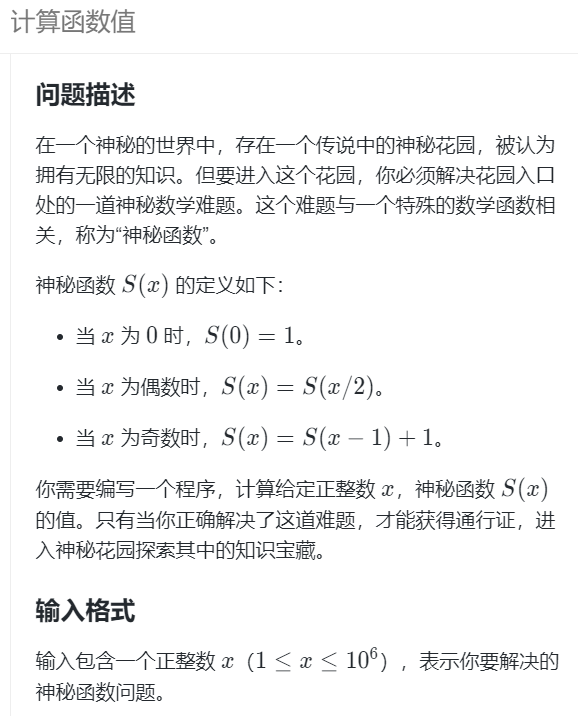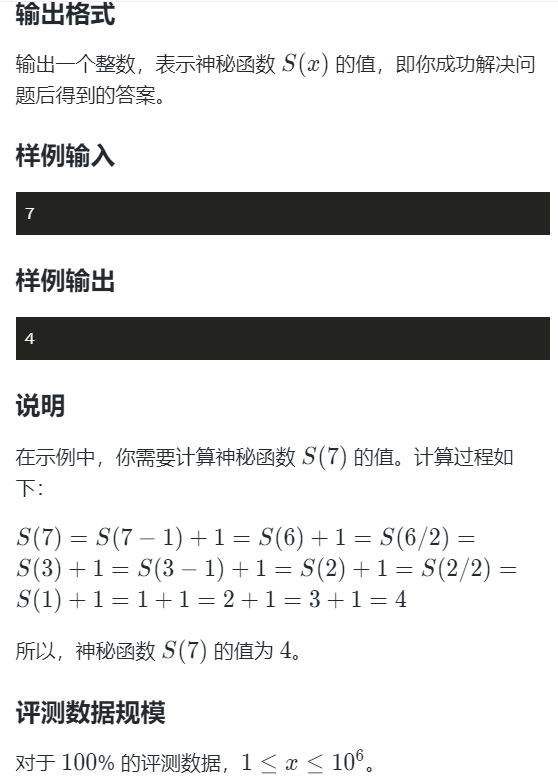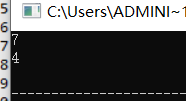蓝桥杯省赛无忧 编程8
发布时间:2024年01月22日



#include <bits/stdc++.h>
using namespace std ;
int readInt() ;
int s (int x ) {
if (x == 0) return 1 ;
if (x & 1) {
return s(x - 1) + 1 ;
}
if (x %2 == 0) {
return s(x / 2) ;
}
}
int main ()
{
int x = readInt () ;
printf ("%d\n" , s(x)) ;
return 0 ;
}
int readInt ()
{
int x = 0, f = 1 ;
char c = getchar () ;
while (c > '9' ||c < '0')
{
if (c == '-') f = -1 ;
c= getchar () ;
}
while (c >='0' &&c <='9')
{
x = x * 10 +c - '0';
c = getchar () ;
}
return x *f ;
}

代码解析
int readInt();
这是readInt()函数的声明,它的定义在main()函数之后。这个函数用于从标准输入读取整数。
int s(int x) {
if (x == 0) return 1;
if (x & 1) {
return s(x - 1) + 1;
}
if (x % 2 == 0) {
return s(x / 2);
}
}
这是“神秘函数”S(x)的实现,它是一个递归函数:
- 如果
x为0,按照定义返回1。 - 如果
x为奇数(x & 1检查x的最低位是否为1),递归调用S(x - 1)并将结果加1。 - 如果
x为偶数(x % 2 == 0检查x是否被2整除),递归调用S(x / 2)。
代码中的偶数检查有些多余,因为如果x不是奇数(x & 1为false),那么它肯定是偶数。
int main() {
int x = readInt();
printf("%d\n", s(x));
return 0;
}
main()函数中,首先调用readInt()函数读取整数x,然后调用s()函数计算S(x)的值,并通过printf将结果打印出来。
int readInt() {
int x = 0, f = 1;
char c = getchar();
while (c > '9' || c < '0') {
if (c == '-') f = -1;
c = getchar();
}
while (c >= '0' && c <= '9') {
x = x * 10 + c - '0';
c = getchar();
}
return x * f;
}
这是readInt()函数的定义,它从标准输入读取连续的字符直到遇到非数字字符停止。该函数能够处理带有负号的整数,并将输入的字符转换为整数值。
文章来源:https://blog.csdn.net/weixin_74774974/article/details/135758068
本文来自互联网用户投稿,该文观点仅代表作者本人,不代表本站立场。本站仅提供信息存储空间服务,不拥有所有权,不承担相关法律责任。 如若内容造成侵权/违法违规/事实不符,请联系我的编程经验分享网邮箱:chenni525@qq.com进行投诉反馈,一经查实,立即删除!
本文来自互联网用户投稿,该文观点仅代表作者本人,不代表本站立场。本站仅提供信息存储空间服务,不拥有所有权,不承担相关法律责任。 如若内容造成侵权/违法违规/事实不符,请联系我的编程经验分享网邮箱:chenni525@qq.com进行投诉反馈,一经查实,立即删除!
最新文章
- Python教程
- 深入理解 MySQL 中的 HAVING 关键字和聚合函数
- Qt之QChar编码(1)
- MyBatis入门基础篇
- 用Python脚本实现FFmpeg批量转换
- 社区人!!年末了,一定别太老实了啊
- 前端面试题-webpack
- BetterDisplay Pro for Mac:精准校准显示器的专业选择
- [C#]C# OpenVINO部署yolov8目标检测模型
- Qt for Android设置安卓程序默认横屏+全屏
- ubuntu部署llama2-chinese
- 抖店怎么提高体验分?团队实操经验分享!
- 【个人记录】创建mysql用户并设置密码支持远程登陆
- 老兵(1)
- nodejs+vue+微信小程序+python+PHP计算机网络在线考试系统-计算机毕业设计推荐